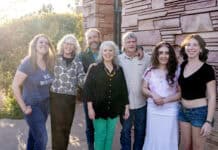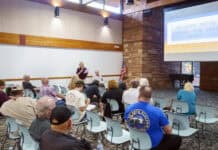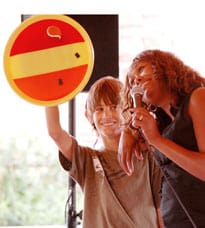Through a program sponsored by Sedona Jazz on the Rocks, festival organizers may have found a few local “Kids Who Love Jazz.”
Larson Newspapers
Through a program sponsored by Sedona Jazz on the Rocks, festival organizers may have found a few local “Kids Who Love Jazz.”
On Friday, Sept. 28, award-winning jazz vocalist Kim Prevost and her husband, award-winning guitarist Bill Solley, stopped by Sedona Charter School and other area schools to teach students some of the basics of jazz.
For “Kids Who Love Jazz,” the two adjusted jazz’s mature stylings to fit a child’s ear. After learning a little about form, structure and rhythm, many students said they had little or no knowledge of jazz before Solley and Prevost stopped by to teach them a few things.
The music of jazz legends like Louis Armstrong, Ella Fitzgerald, John Coltrane, Dizzy Gillespie, Nat King Cole, Benny Goodman and Charlie Parker seemed to wash over some of the students, but others appeared deeply moved by the experience.
Fifth-grader Jersey Gould discovered a strong respect for saxophonist Coltrane during the presentation.
“It was cool to see all the old jazz artists and learn about them,” Gould said. “Jazz is really cool.”
Some kids are so affected by their first experience with jazz that they run home to beg their parents for a set of drums, a guitar or a saxophone, Solley said.
The seven-string guitar, Solley’s instrument of choice, is a rarity in the jazz world — one more commonly found in hard rock music. But the seventh note — in this case, a low A — allows Solley to weave bass lines into his playing, he said.
That suits him and Prevost well since they typically travel without a bass player. They’ve played all over the world together, and since both have backgrounds in education, dropping by a few schools to give children a dose of jazz makes sense, Solley said.
“I really enjoy it,” one SCS student said of jazz — “because it’s like you play the song and then you mess it up a lot.”
Prevost chuckled. That’s improvisation, she explained.
“Jazz is a musical conversation …. We communicate with our instruments,” she said.
Sixth-grader Sabrina Sypniewski appreciated the introduction to rhythm and tempo while Anna Johnson, also a sixth-grader, enjoyed learning about the history of jazz and where it all came from, she said.
Jazz originated in neighborhoods in and around New Orleans near the turn of the 20th century, Prevost told students.
As New Orleans natives, she and Solley were well-dug into the city’s music scene when Hurricane Katrina hit in 2005 and demolished their home.
Uprooted, they spent the next year or so on the road. First, in Miami, gigging with Cuban jazz legend Arturo Sandoval before traveling to Houston, to meet up with Prevost’s family, also Katrina evacuees, Solley said.
For Prevost, the hurricane really put life into perspective. She and Solley escaped the storm with their lives and the life of their 4-year-old daughter, Sophia, so the little things that once seemed worth worrying about don’t seem that important anymore, she said.
“The stuff we lost was just stuff,” Solley said. “[Katrina] took our home, but it didn’t take our talent.”
Of the thousands of people forced from their homes by the storm, few have returned to New Orleans. The city will never be the same, Solley said, and he’s not sure if he and Prevost will ever return to live there again.
“It’s like you’ve got this void,” Solley explained, “this feeling of emptiness, because of all those people who haven’t returned.”
But at least one good thing came out of it all, Solley said. The storm scattered New Orleans musicians in every direction, so the sounds born and bred on the streets of the city are now reaching new audiences.
In tune with that, Solley and Prevost have kept themselves on the move. Their trip to Sedona, although part of the Sedona Jazz on the Rocks Festival, is part of a larger mission — to keep jazz alive in the minds of young people who will one day be asked to carry it on.
“Jazz is always changing,” Prevost told SCS children. “It’s always moving.”
Being a professional musician requires love, patience and a lot of practice, but “get involved with music,” Prevost said. “It’ll be the greatest gift of your entire lives.”
Tyler Midkiff can be reached at 282-7795, Ext. 122, or e-mail to tmidkiff@larsonnewspapers.com





















